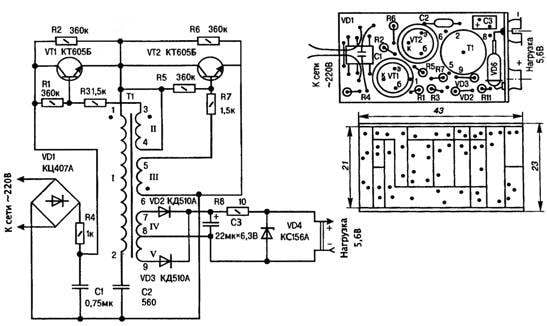
When you turn on the power source smoothing capacitor C1 is gradually charged via the resistor R4, serves to protect the diode bridge VD1 overload. There is a voltage at the output of the trigger divider. Due to the fact that it affects the resonant circuit, consisting of transformer T1 and capacitor C2 in the secondary winding II is induced EMF from the pulse, the power of which is sufficient to switch the transistor VT1 is in the saturation state, although the initial moment of time the current through this semiconductor triode is not due to the self-inductance of T1. Then starts to do the “addition” from the winding II, holding VT1 is in the fully open position.
The VT2 transistor during the half cycle of the oscillatory process is fully locked. It holds in this state, the EMF that is induced in the winding III. But after the charge of the capacitor C2 the current through VT1 stops and it closes.
However, the oscillatory process in the circuit T1C2 does not end there. The result is current. Originating at the beginning of the second period (when the transistors are in the closed state), it will flow through the second arm of the trigger divider, which consists of parallel connected to R6 and the emitter-collector conduction VT2.
Similarly considered phase opens the VT2 transistor and held in the fully open position. However, after the discharge of the capacitor C2, the transistor VT2 is closed.
The transistors operate with minimal losses of energy in the most advantageous key mode. The current flowing through them, the entire specified bandwidth of the oscillating circuit.
Thus, a device and there is nothing like economical attenuator (attenuator) the current passing through the load. Output energy is removed from circuit the windings IV and V. the high Frequency oscillations are straightened diodes VD2, VD3, and a smoothing capacitor CP. The output of the Zener diode VD4, in parallel to which can be connected load up to 40 mA. With more tokoeka consumers increased low frequency ripple and reduced output voltage.
As shown by years of exploitation, this adapter does not fail in different situations, until the closed-loop output buses with the extreme 200 mA. Due to the resonant properties of the oscillating circuit is a partial smoothing of the low-frequency ripple at low load (the smaller, the higher is the smoothing). However, the quality factor drops sharply when the voltage at the ends of the windings IV and V exceeds the voltage on the capacitor of Sz, since the contour is given energy.
The high q of the circuit, occurring in the absence of selection from it of energy, leads to the achievement of equal voltages. This occurs due to a resonance even at a lower value pulsing Ubx. But further growth of the voltage on the resonant circuit does not occur due to the sharp fall of the quality factor caused by the energy extraction.
Now about the parts and components of the adapter design. Transformer T1 is made on a ferrite ring К10х6х5 1000НН. Windings I, II, III, IV, V contain, respectively, 400, 30, 30, 20 and 20 turns of wire PELCO-0,07. The high reliability of this transformer guarantees high-quality production with good PVC winding insulation (for example, using a condenser or tissue paper).

